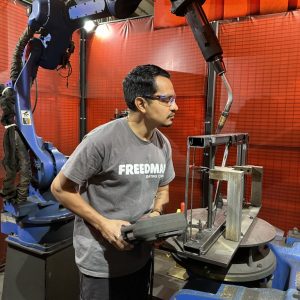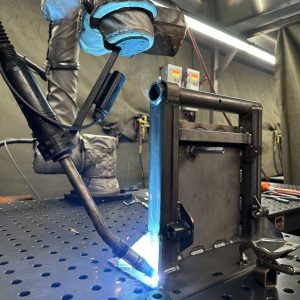Metal fabrication shops share experiences with using cobots and other welding automation.
Welding automation is nothing new for Marvin Herrera and Corey Mays, as their jobs have incorporated it in some form or another for years. Their respective workplaces, Freedman Seating Co. and CM Welding & Machine, had traditional robotic cells in place.
Both companies have introduced cobots to their respective shop floors over the past few years. It was these experiences that brought them to Ohio State University last October for the American Welding Society’s Welding Automation Expo & Conference.
The three-day event featured presentations on how legacy manufacturers can rethink automation, the current and future state of welding, improving efficiency, and welding automation challenges and solutions. Multiple welding equipment and cobot manufacturers were on hand for demonstrations and information. Some attendees also visited Ohio State’s Mars G. Fontana Laboratories and the facilities of nearby Path Robotics and EWI.

Cobots have helped Freedman Seating Co. and CM Welding & Machine reduce or eliminate labor shortages and production bottlenecks—all while not being entirely difficult to master. But as Mays, Herrera, and others at the conference pointed out, these robotic systems still have limitations.
“Understand your application, understand that automation can assist and can help, but it won’t solve all,” said Mays, the president of CM Welding & Machine, Midland, Texas.
The experiences they shared may have sounded familiar to some of the attendees that week. For others, though, it may have been eye opening.
Make a Seat
The introduction of welding cobots to Chicago-based Freedman was an opportunity for Herrera to make a name for himself within the company. He had risen from welder to welding engineer over a span of a few years.
Freedman—a family-owned company that’s been around for more than 125 years making seats for buses, RVs, and other modes of transportation—had also shown willingness to adopt and improve welding automation in its operations. Prior to 2019, Freedman had multiple Yaskawa Motoman traditional robotic cells in place. Freedman had found ways to improve efficiency, such as by reducing the number of cells and manual welders necessary to make a part. This decision led to a reduced part cycle time.
When Herrera was tasked with finding new technology that could improve speed, weld quality, and parts production, he gravitated toward cobots after attending FABTECH and learning more about them.

“I remember reading about them and I was like, ‘Oh, these cobots sound cool. It’s something new. I haven’t heard too much about them,’” he said.
The company president was into the idea of new technology, so the Freedman team gave Herrera the OK to invest in a cobot in 2020. This investment became even more urgent when the COVID-19 pandemic made a significant dent in the company’s workforce.
“At the end of 2020, he said to me, ‘How quickly can you get it in here?’” Herrera recalled. The company’s first cobot—from Vectis Automation—arrived just before the end of that year.
Herrera tasked the cobot with the production of a polished stainless steel transit seat—Freedman’s first automation project that involved stainless. Prior to cobots, Freedman’s traditional welding robots worked primarily on carbon steel. Some said it couldn’t be done, but Herrera believed in the cobot’s potential.
The cobot revealed new possibilities to Herrera, such as how to improve fixturing and how to make parts production more efficient.
“We had some fixtures where … there were a lot of clamps in this fixture. It was two operations. They had to weld the bottom of the seat, take it out, flip it, and then weld the top seat or the top part of the seat, and it took a welder about 12 minutes to weld one seat,” he said. Fixturing improvements and the cobot’s ability to move from one welding table to another allowed them to make the part much quicker.
“And now we get one part every 3 ½ minutes. So about every seven minutes, we’re getting two parts,” Herrera said—roughly a 200% productivity increase.
The cobot only works on this particular stainless steel seat. “We don’t break the setup. It’s just constantly running that same part,” he said.
Since then, Freedman has implemented two more cobots for use primarily on carbon steel parts for midsize vehicle seats. As the company adjusts to an increased demand for carbon steel seating, it has shifted some of the work away from traditional robots in favor of the cobots to alleviate the traditional robots’ workload, Herrera said.
For Freedman, welding automation has proven successful. But Herrera advised shops to do their research and make sure a cobot is the right fit for them. He suggests shops ask themselves: Do we have the space for a cobot? Are we producing high-volume parts? Is our shop ready for welding automation equipment?
“Traditional [robots] are always going to outrun cobots in welding times, but there’s a place and time for each. You need to weigh out what makes sense to you,” he said.
Manual welders are still needed, even in a more automated welding bay, Herrera added. In fact, cobots and industrial welding robots may motivate employees to tap into their own potential. Two cobot operators he trained used to work in materials handling, but now they are in welding school learning to become better welders.
“I’m sure you have people out there on the floor that are trainable, coachable—you want to pinpoint them,” he said.
“You don’t want them to be scared or fearing the cobot is taking jobs,” he continued. “I think we did a good job because a lot of them noticed that cobots would alleviate some of their stress, their pains, and they could see the benefits.”
Continue reading the full article here.
This article was originally published in The Fabricator Magazine’s January 2024 issue by Rafael Guerrero.
